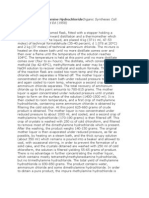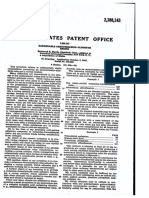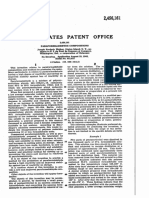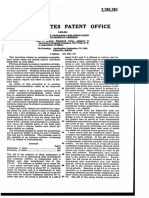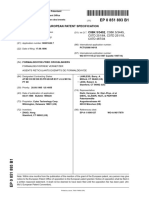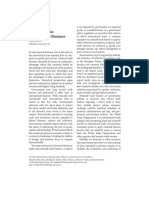0 ratings0% found this document useful (0 votes)
17 viewsUS2482508
US2482508
Uploaded by
هیمن مThis patent describes a process for modifying methylol melamine ether resins by reacting them with ortho esters of silicon under anhydrous conditions. Specifically, it involves reacting an alkyl ether of methylol melamine, such as methyl ether of hexamethylol melamine, with an ortho silicate like tetraethyl orthosilicate or dimethyl diethyl orthosilicate. The resulting modified resins are soft, rubbery, and water-white, and can be partially or fully cured. They have applications as coatings, laminates, adhesives, and more.
Copyright:
© All Rights Reserved
Available Formats
Download as PDF, TXT or read online from Scribd
US2482508
US2482508
Uploaded by
هیمن م0 ratings0% found this document useful (0 votes)
17 views2 pagesThis patent describes a process for modifying methylol melamine ether resins by reacting them with ortho esters of silicon under anhydrous conditions. Specifically, it involves reacting an alkyl ether of methylol melamine, such as methyl ether of hexamethylol melamine, with an ortho silicate like tetraethyl orthosilicate or dimethyl diethyl orthosilicate. The resulting modified resins are soft, rubbery, and water-white, and can be partially or fully cured. They have applications as coatings, laminates, adhesives, and more.
Copyright
© © All Rights Reserved
Available Formats
PDF, TXT or read online from Scribd
Share this document
Did you find this document useful?
Is this content inappropriate?
This patent describes a process for modifying methylol melamine ether resins by reacting them with ortho esters of silicon under anhydrous conditions. Specifically, it involves reacting an alkyl ether of methylol melamine, such as methyl ether of hexamethylol melamine, with an ortho silicate like tetraethyl orthosilicate or dimethyl diethyl orthosilicate. The resulting modified resins are soft, rubbery, and water-white, and can be partially or fully cured. They have applications as coatings, laminates, adhesives, and more.
Copyright:
© All Rights Reserved
Available Formats
Download as PDF, TXT or read online from Scribd
Download as pdf or txt
0 ratings0% found this document useful (0 votes)
17 views2 pagesUS2482508
US2482508
Uploaded by
هیمن مThis patent describes a process for modifying methylol melamine ether resins by reacting them with ortho esters of silicon under anhydrous conditions. Specifically, it involves reacting an alkyl ether of methylol melamine, such as methyl ether of hexamethylol melamine, with an ortho silicate like tetraethyl orthosilicate or dimethyl diethyl orthosilicate. The resulting modified resins are soft, rubbery, and water-white, and can be partially or fully cured. They have applications as coatings, laminates, adhesives, and more.
Copyright:
© All Rights Reserved
Available Formats
Download as PDF, TXT or read online from Scribd
Download as pdf or txt
You are on page 1of 2
Patented Sept. 20.
1949 ' 2,482,508 1"
. UNITED srAras PATENT OFFICE 2,482,508
MODIFIED METHYLOL MELsMmc aasms
Mass. assignor to
Stuart 11. Rider, Spring?eld, St. Louis, Mo., a \
Monsanto Chemical Company,
" corporation of Delaware
at niawinr. Application August 21, 1946,
Serial No. 692,137
8 Claims. (Cl- 260-673)
softened and regained its normal hardness after
This invention relates to modi?ed methylol drying for 15 minutes. ,
melamine ether resins. More particularly it re The ortho- silicates which may be used to pro
lates to methylol melamine ether resins modi?ed duce the resins of this invention are the alkyl .
with ortho esters of silicon. derivatives of ortho silicic acid. The alkyl sub
An object of this invention is to provide modi stituents may be identical or‘ two or more dif
?ed methylol melamine ether resins. ferent alkyl substituents may be present. Ex
A further object is to modify methylol mela amples of the ortho silicates are tetramethyl,
mine ether resins with ortho esters of silicon. tetraethyl, tetrabutyl, tetraisobutyl, tetraamyl,
vThese and other objects are attained by re 10 tetrahexyl, dimethyl diethyl, diethyl dibutyl, etc.
acting an ether of a methylol melamine with orthosilicates. ,
an ortho ester. of silicon under anhydrous condi The methylol melamine ethers which may be
used are the alkyl ethers of any of the methylol
tions.
The following examples are given to illustrate meiamines from mono to hexamethylol mela
this invention and are not intended to limit the mines or mixtures of the same. Thus the methyl,
scope thereof. ~Where parts are mentioned they 15 ethyl, propyl, isopropyl, butyl, isobutyl, amyl,
are parts by weight. hexyl, octyl ethers of mono, di dri, vtetra,
Example I penta or hexamethylol, melamines' may be
- used. Care must be taken to eliminate all water
300 parts (about .‘15 mol) of an anhydrous including water I of crystallization from the
methyl ether of hexamethylol melamine were 20 methylol melamine ethers prior to the reaction
mixed with 200 parts (about 1 mol) of tetraethyl with the ortho silicates.
ortho silicate in a suitable vessel provided with The ratio of methylol melamine ether to alkyl
a re?ux condenser. A calcium chloride tube was ortho silicate may be varied over a wide range
placed in the top of the condenser to exclude e. g. 1 mol of methylol melamine ether may be
moisture during the reaction. The mixture was 25 reacted with from about 0.2 to 3 or more mols
heated at 150° C. for 21/2 hours. Excess silicate of alkyl ortho silicate. An excess of the alkyl
ester was removed by distillation to yield a rub ortho silicate may be used and the excess re
bery water-white resin, insoluble in water and moved by distillation after completion of the re
soluble in xylol. 30 action. ‘ ,
Example II The temperature of the reactionv may be varied
from about 100 to about 200° C. with a. resultant
650 parts (about 1 mol) of an anhydrous butyl decrease in the reaction time from about 4 hours
ether of hexamethylol melamine were mixed with at 100° C. to about 1 hour at 200° C. No catalyst
200 parts (about 1 mol) of tetraethyl ortho sili
cate in a suitable container fitted with a re?ux35 need be used to accelerate the reaction.
The resins of this invention are soft, rubbery,
condenser and a calcium chloride moisture trap. and generally water-white. They are softened
The mixture was heated at 180° C. for 2 hours. slightly by water and are soluble in hydrocarbon
Excess silicate ester was removed by distillation solvents especially those of the aromatic series.
to produce a soft rubbery water-white resin solu The resins may be partially cured without cata
ble in aromatic hydrocarbons such as benzene, lysts at ,from about 120° C. to about 300° C. to
xylol, etc. ' r. produce hard, glossy ?exible ?lms. They are
Example III still soluble in aromatic hydrocarbons and will
soften slightly when immersed in water but re
400 parts (about 1 mol) of an anhydrous methyl 45 cover their original hardness on removal of the
ether of hexamethylol melamine were mixed with water.
180 parts (1 mol) of dimethyl diethyl ortho The resins may be further cured to an insolu
silicate in a suitable container provided with a ble. infusible, water-inert stage by incorporating
re?ux condenser and a calcium chloride moisture an acid catalyst therein and heating at about 100
trap. The mixture was reacted at 130° C. for 50 to about 200° C. The fully cured resins are ex
4 hours. Excess silicate ester was then removed tremely hard. .
by distillation to produce a soft rubbery water An unusual feature of- the uncured resins of
white resin soluble in aromatic hydrocarbons. ' this invention is their
low viscosity coefficient.
The reaction conditions must be anhydrous For example, at the end of the reaction producing
to produce the resins of this invention since the 55 the resins, the resins are so sti? and viscous that
ortho silicates readily hydrolyze in the presence they will ride up and cling to the stirring device
of even very small amounts of water. After the even though the temperature is about 150° 0.;
reaction is completed, water has only a slight yet at room temperature, ca. 30° C., they are still
softening e?ect on the resin and does not cause soft rubbery materials.
hydrolysis. For example a partially cured ?lm 60 The uncured resins are compatible with alkyd
immersed in water for 18 hours was. only slightly
' resins increasing the hardness oi ?lms cast there
from.
4
5. The process as in claim 4 wherein the alkyl
The uncured resins may be used in ‘coating ether of methylol melamine is the methyl ether
compositions as modi?ers for alkyd resins. They of hexamethylol melamine. . ‘
may also be used for impregnating paper, glass 6. The process as in claim’ 4 wherein the alkyl
and textile webs for use in laminates. They are ether of methylol melamine is the butyl ether of
valuable as adhesives particularly in the’ making hexamethylol melamine.
of abrasives. 7. The process which comprises reacting 1 mol
The uncured resins may be modi?ed by the in of the methyl ether of hexamethylol melamine
corporation of conventional additives such as 10 with from 0.2 to 3 mols of tetraethyl orthosilicate
?llers, pigments, dyes, etc. under substantially anhydrous conditions at tem
It is obvious that many variations may be made peratures of from 100 to 200° C.
in the products and processes of this invention 8. The process which comprises reacting 1 mol
without departing from the spirit and scope of the methyl ether of hexamethylol melamine
thereof as de?ned in the appended claims. with from 0.2 to 3 mols of dimethyl diethyl ortho
What is claimed is: silicate under substantially anhydrous conditions
1. The resinous heat reaction product under at temperatures from 100 to 200° C.
substantially anhydrous conditions of 1 mo] 01' STUART H. RIDER.
an alkyl ether of methylol melamine with from
0.2 to 3 mols of an alkyl ortho silicate. REFERENCES CITED
2. The resinous heat reaction product under 20 The following references are 01' record in the
substantially anhydrous conditions of 1 mol of file of this patent:
the methyl ether of hexamethylol melamine with
from 0.2 to 3 mols of tetraethyl orthosilicate. UNITED STATES PATENTS
3. The resinous heat reaction product under Number Name Date
substantially anhydrous conditions or 1 mol of 25 2,187,566 Bruson __________ _.. Jan. 16, 1940
the methyl ether of hexamethylol melamine with 2,313,678 Simons __________ __. Mar. 9, 1943
from 0.2 to 3 mols of dimethyl diethyl orthosili 2,320,817 D'Alelio _____.______ June 1, 1943
cate.
4. The process which comprises reacting 1 mol . ‘ FOREIGN PATENTS
of an alkyl ether of a methylol melamine with 30 Number Country Date
698,389 Germany ________ __ Nov. 8, 1940
OTHER REFERENCES
O?icial Digest, November 1945, pages 424-441.
You might also like
- J. Sheehan, Richard - Ullmann's Encyclopedia of Industrial Chemistry - Terephthalic Acid, Dimethyl Terephthalate, and Isophthalic AcidDocument13 pagesJ. Sheehan, Richard - Ullmann's Encyclopedia of Industrial Chemistry - Terephthalic Acid, Dimethyl Terephthalate, and Isophthalic AcidNithya SethuganapathyNo ratings yet
- Soran University Faculty of Engineering Department of Chemical EngineeringDocument25 pagesSoran University Faculty of Engineering Department of Chemical EngineeringHalo BashirNo ratings yet
- US2703794Document4 pagesUS2703794Sandeep SomaiyaNo ratings yet
- United States Patent Office: Fa'renied Nov. '13, 1951Document3 pagesUnited States Patent Office: Fa'renied Nov. '13, 1951هیمن مNo ratings yet
- United States Patent 0 " Ice: Ludwigshafen (Rhine), GermanyDocument2 pagesUnited States Patent 0 " Ice: Ludwigshafen (Rhine), Germanyهیمن مNo ratings yet
- United States Patent Office: Patented Nov. 14, 1950Document5 pagesUnited States Patent Office: Patented Nov. 14, 1950Chandra AdityaNo ratings yet
- Ullmann's Enc. of Industrial ChemistryDocument13 pagesUllmann's Enc. of Industrial ChemistryEstela HirataNo ratings yet
- Acrylic Modified Water Soluble Oil Based CoatingsDocument4 pagesAcrylic Modified Water Soluble Oil Based Coatingsichsan hakimNo ratings yet
- EP0530628B1 ThermoplastiqueDocument11 pagesEP0530628B1 ThermoplastiquepnpexpertsNo ratings yet
- Us2618651 Patent Pemilihan ProsesDocument3 pagesUs2618651 Patent Pemilihan Proseswidi widianiNo ratings yet
- US2465319Document7 pagesUS2465319Sebastian GonzalezNo ratings yet
- Methylamine RecipeDocument4 pagesMethylamine RecipeVanilla470% (1)
- Ethylene Urea JACS 1Document10 pagesEthylene Urea JACS 1tavolenNo ratings yet
- Receipe For MethylamineDocument3 pagesReceipe For MethylamineCharles Sullivan100% (1)
- Aliphatic AminesDocument2 pagesAliphatic AminesAmar PandeyNo ratings yet
- RayonDocument9 pagesRayonRahul GuptaNo ratings yet
- US3632822Document6 pagesUS3632822Agustin CantilloNo ratings yet
- #US2703316Document3 pages#US2703316Citra Adelina SitorusNo ratings yet
- United States Patent (191: PieschDocument6 pagesUnited States Patent (191: Pieschهیمن مNo ratings yet
- 0304 S1 Abs PDFDocument7 pages0304 S1 Abs PDFFajar RumantoNo ratings yet
- DSGHRTHDDocument12 pagesDSGHRTHDMary Grace VelitarioNo ratings yet
- Synthesis of Nanocrystalline 8 Mol% Yttria Stabilized Zirconia by The Oleate Complex RouteDocument5 pagesSynthesis of Nanocrystalline 8 Mol% Yttria Stabilized Zirconia by The Oleate Complex Routeamirlove206No ratings yet
- Laporan Praktikum Kimia Organik Ii: Metil SalisilatDocument13 pagesLaporan Praktikum Kimia Organik Ii: Metil SalisilatSallyna HendrikNo ratings yet
- Polyesters For Use in The Fibreglass Industry: Step 1 - PolymerisationDocument8 pagesPolyesters For Use in The Fibreglass Industry: Step 1 - PolymerisationAtif AzamNo ratings yet
- Bioethanol Manufacturing From Lignocellulosic BiomassDocument7 pagesBioethanol Manufacturing From Lignocellulosic BiomassRifqiNo ratings yet
- % Atom Economy Yield of Potash Alum by Green Chemistry MethodsDocument3 pages% Atom Economy Yield of Potash Alum by Green Chemistry MethodsNeel0% (1)
- Us1995970 PDFDocument3 pagesUs1995970 PDFCitra Adelina SitorusNo ratings yet
- Production of AcrylonitrileDocument91 pagesProduction of AcrylonitrileGunNo ratings yet
- A26 193Document13 pagesA26 193Syarif HidayatNo ratings yet
- US3287323Document3 pagesUS3287323marator204No ratings yet
- 2001 FTIR Studies of The Curing Reactions of Palm Oil Alkyd - Melamine EnamelsDocument7 pages2001 FTIR Studies of The Curing Reactions of Palm Oil Alkyd - Melamine EnamelsozgnondrNo ratings yet
- United States Patent 0: Patented May 23, 1967 2Document3 pagesUnited States Patent 0: Patented May 23, 1967 2SebastianCalleNo ratings yet
- Mine SynthesisDocument3 pagesMine SynthesisriskobinskoNo ratings yet
- United States Patent Office: of 125 C.P.SDocument3 pagesUnited States Patent Office: of 125 C.P.SAnonymous C3BD7OdNo ratings yet
- Polymer: Neslihan Alemdar, A. Tuncer Erciyes, Niyazi BicakDocument7 pagesPolymer: Neslihan Alemdar, A. Tuncer Erciyes, Niyazi Bicaklivius12No ratings yet
- 2017CHE008 DetailedProcessDescription1Document17 pages2017CHE008 DetailedProcessDescription1Xi Liinett AqkoNo ratings yet
- Nov. 15, 1949 N. E. Searle 2,487,832Document4 pagesNov. 15, 1949 N. E. Searle 2,487,832Nitish Singh SengarNo ratings yet
- Miscellaneous ChemicalsDocument8 pagesMiscellaneous Chemicalsgbonger100% (9)
- Us 2556488Document3 pagesUs 2556488Ghina Fatikah SalimNo ratings yet
- LECTURE - 6: Ethylene Derivatives: Ethylene Oxide and Ethanol Amines 6.1 Ethylene OxideDocument7 pagesLECTURE - 6: Ethylene Derivatives: Ethylene Oxide and Ethanol Amines 6.1 Ethylene Oxideمحمود محمدNo ratings yet
- Vinyl AcetateDocument5 pagesVinyl AcetateroxetteNo ratings yet
- US3029298Document2 pagesUS3029298Muhammad Akbar FahleviNo ratings yet
- Patented Get. 31, 1961: by Fractional Distillation.Document3 pagesPatented Get. 31, 1961: by Fractional Distillation.neni ratna sariNo ratings yet
- US3398124Document3 pagesUS3398124Siti RahmaliaNo ratings yet
- Invention of EVA-US2200429Document3 pagesInvention of EVA-US2200429mac9papNo ratings yet
- Castor OilDocument6 pagesCastor OilÖzlem YılmazNo ratings yet
- Fields of Advanced Difficulty: PracticalDocument15 pagesFields of Advanced Difficulty: PracticalLê Hoàng MinhNo ratings yet
- Us1913405 PDFDocument4 pagesUs1913405 PDFNatijatul HabibahNo ratings yet
- UntitledDocument15 pagesUntitledkushwanth Kumar adariNo ratings yet
- Hydrotreating and Hydrocracking CatalystDocument4 pagesHydrotreating and Hydrocracking CatalystcmineliandreeaNo ratings yet
- Unite States Ice: AtentDocument2 pagesUnite States Ice: Atentهیمن مNo ratings yet
- Formulating Silicone Adhesives Rubbers and GelsDocument123 pagesFormulating Silicone Adhesives Rubbers and Gelskreci1100% (1)
- Chapter One: Literature ReviewDocument18 pagesChapter One: Literature ReviewAhmed ShabanNo ratings yet
- Catalizator Pentru Hidrogenarea Uleiului Vegetal - Articol ȘtiințificDocument10 pagesCatalizator Pentru Hidrogenarea Uleiului Vegetal - Articol ȘtiințificcmineliandreeaNo ratings yet
- Esters OrganicDocument34 pagesEsters OrganicSh4d0wSt4lk3r11No ratings yet
- Acetate RayonDocument3 pagesAcetate Rayonmaya_muthNo ratings yet
- Syndets and SurfactantsDocument8 pagesSyndets and SurfactantsAdrian Delgado QuesadaNo ratings yet
- Thioglycolic Acid ProductionDocument2 pagesThioglycolic Acid Productionfake77No ratings yet
- United States Patent (19) : Quednau Mar. 21, 1995Document7 pagesUnited States Patent (19) : Quednau Mar. 21, 1995هیمن مNo ratings yet
- Setathane® D 1150: Type UsesDocument2 pagesSetathane® D 1150: Type Usesهیمن مNo ratings yet
- Us4746462 PDFDocument7 pagesUs4746462 PDFهیمن مNo ratings yet
- US20070293692A1Document7 pagesUS20070293692A1هیمن مNo ratings yet
- Cymel® 303 LF: Product Description Typical PropertiesDocument2 pagesCymel® 303 LF: Product Description Typical Propertiesهیمن مNo ratings yet
- Setathane® D 1160: Type UsesDocument2 pagesSetathane® D 1160: Type Usesهیمن مNo ratings yet
- United States Defensive Publication (19101) (111: WalkerDocument1 pageUnited States Defensive Publication (19101) (111: Walkerهیمن مNo ratings yet
- United States ' Patent Office: Hardenable Aminotbiazine-AhjehydeDocument2 pagesUnited States ' Patent Office: Hardenable Aminotbiazine-Ahjehydeهیمن مNo ratings yet
- Us2456161 PDFDocument3 pagesUs2456161 PDFهیمن مNo ratings yet
- United States Patent 0: Patented Sept. 30, 1969Document2 pagesUnited States Patent 0: Patented Sept. 30, 1969هیمن م0% (1)
- United States Patent Office: Patented Sept. 25, 1945Document2 pagesUnited States Patent Office: Patented Sept. 25, 1945هیمن مNo ratings yet
- United States Patent 0 ": Main, Germany Claims Priority, Application Germany, Aug. 10, 1963Document1 pageUnited States Patent 0 ": Main, Germany Claims Priority, Application Germany, Aug. 10, 1963هیمن مNo ratings yet
- United States I Patent (19) : Blasing Et Al. Jul. 3, 1984Document3 pagesUnited States I Patent (19) : Blasing Et Al. Jul. 3, 1984هیمن مNo ratings yet
- Unite States Ice: AtentDocument2 pagesUnite States Ice: Atentهیمن مNo ratings yet
- United States Patent (191: PieschDocument6 pagesUnited States Patent (191: Pieschهیمن مNo ratings yet
- KKKKKK - Ep1671987a1Document12 pagesKKKKKK - Ep1671987a1هیمن مNo ratings yet
- European Patent Specification C08G 2/08, C08K 5/17,: Printed by Jouve, 75001 PARIS (FR)Document15 pagesEuropean Patent Specification C08G 2/08, C08K 5/17,: Printed by Jouve, 75001 PARIS (FR)هیمن مNo ratings yet
- KKKK - Us2918452Document5 pagesKKKK - Us2918452هیمن مNo ratings yet
- KKKKKK - US4057523 - Very GoodDocument8 pagesKKKKKK - US4057523 - Very Goodهیمن مNo ratings yet
- KKKK Us4143016Document4 pagesKKKK Us4143016هیمن مNo ratings yet
- European Patent Specification C08K 5/3492, C08K 5/3445,: C07D 251/64, C07D 251/18, C07D 487/04Document31 pagesEuropean Patent Specification C08K 5/3492, C08K 5/3445,: C07D 251/64, C07D 251/18, C07D 487/04هیمن مNo ratings yet
- KKKK Us4081426Document9 pagesKKKK Us4081426هیمن مNo ratings yet
- KKK Us20020000536Document12 pagesKKK Us20020000536هیمن مNo ratings yet
- Joint Briefing PaperDocument6 pagesJoint Briefing PaperFIDH FIDHNo ratings yet
- Lecture 5Document33 pagesLecture 5aNo ratings yet
- DPC MCQDocument9 pagesDPC MCQNiraj Pandey100% (3)
- Identifying Places Where Earthquakes OccurDocument44 pagesIdentifying Places Where Earthquakes Occur卄丂・SevouツNo ratings yet
- Case Report ForensikDocument18 pagesCase Report ForensikmandalikaNo ratings yet
- Government Intervention in International Business: Gary Knight Willamette University, USADocument2 pagesGovernment Intervention in International Business: Gary Knight Willamette University, USARavi ShankarNo ratings yet
- Beauty CareDocument12 pagesBeauty CareMary Rhea Revestir Ileto75% (4)
- PRO521 Safety in DesignDocument16 pagesPRO521 Safety in DesignHedi Ben MohamedNo ratings yet
- Reflection Essay Group13Document17 pagesReflection Essay Group13Nur Zahirrah MalikNo ratings yet
- CLJ 3 - Lecture 1Document22 pagesCLJ 3 - Lecture 1Euben PatronNo ratings yet
- Kelas 5 - Soal PASDocument12 pagesKelas 5 - Soal PASikhsanNo ratings yet
- State Vs On 8 November 2021Document19 pagesState Vs On 8 November 2021simuleguminternshipsNo ratings yet
- CIM 05 Arion Banki HFDocument74 pagesCIM 05 Arion Banki HFVivek SrinivasanNo ratings yet
- PLEASANTVILLE DEVELOPMENT CORPORATION vs. COURT OF APPEALSDocument3 pagesPLEASANTVILLE DEVELOPMENT CORPORATION vs. COURT OF APPEALSian sabornidoNo ratings yet
- RRB Alp Assistant Loco Pilot Technician Solved Papers in Hindi - All Trade & ShiftDocument480 pagesRRB Alp Assistant Loco Pilot Technician Solved Papers in Hindi - All Trade & ShiftflyNo ratings yet
- Nterview With Dan Zanger: TradersworldDocument98 pagesNterview With Dan Zanger: TradersworldMichael RomeroNo ratings yet
- DERECHO MODULO III Parte 3 - BRUNODocument33 pagesDERECHO MODULO III Parte 3 - BRUNOCleyder Kevin Cubas Tapia100% (1)
- Bank Soal Kelas Xi Ipa & IpsDocument14 pagesBank Soal Kelas Xi Ipa & Ipsananurhasanah061006No ratings yet
- Personal Fall Protection Equipment - Anchor Devices: BSI Standards PublicationDocument48 pagesPersonal Fall Protection Equipment - Anchor Devices: BSI Standards PublicationAndrew LiddellNo ratings yet
- Elements of SCMDocument6 pagesElements of SCMPraveen ShuklaNo ratings yet
- Oral PresentationDocument1 pageOral PresentationSofia NicodemosNo ratings yet
- Assyrian Propaganda For The WestDocument22 pagesAssyrian Propaganda For The WestAlex CarnNo ratings yet
- Unit 4 - IPR & Regulation To InformationDocument17 pagesUnit 4 - IPR & Regulation To InformationIIHT VARANASINo ratings yet
- DM 110 Resources For Catch Up Fridays and Prohibition of Assigning Extraneous Tasks and Reports To TeachersDocument4 pagesDM 110 Resources For Catch Up Fridays and Prohibition of Assigning Extraneous Tasks and Reports To TeachersGeralyn CorotNo ratings yet
- Skin LesionDocument6 pagesSkin LesionDuchess Juliane Jose MirambelNo ratings yet
- Trostruka MantraDocument4 pagesTrostruka MantraSlaavoNo ratings yet
- G.R. No. 161135. April 8, 2005 Swagman Hotels and Travel, Inc., Petitioners, Hon. Court of Appeals, and Neal B. Christian, RespondentsDocument12 pagesG.R. No. 161135. April 8, 2005 Swagman Hotels and Travel, Inc., Petitioners, Hon. Court of Appeals, and Neal B. Christian, RespondentszNo ratings yet
- MINUTES OF LAC SESSION Sept.24 MODULE 4Document7 pagesMINUTES OF LAC SESSION Sept.24 MODULE 4Allyn Marie RojeroNo ratings yet
- SPM Unit 5 NotesDocument26 pagesSPM Unit 5 Notesabhishekgs100% (3)
- SMFWBC Week 1Document8 pagesSMFWBC Week 1qt SamanthNo ratings yet
































